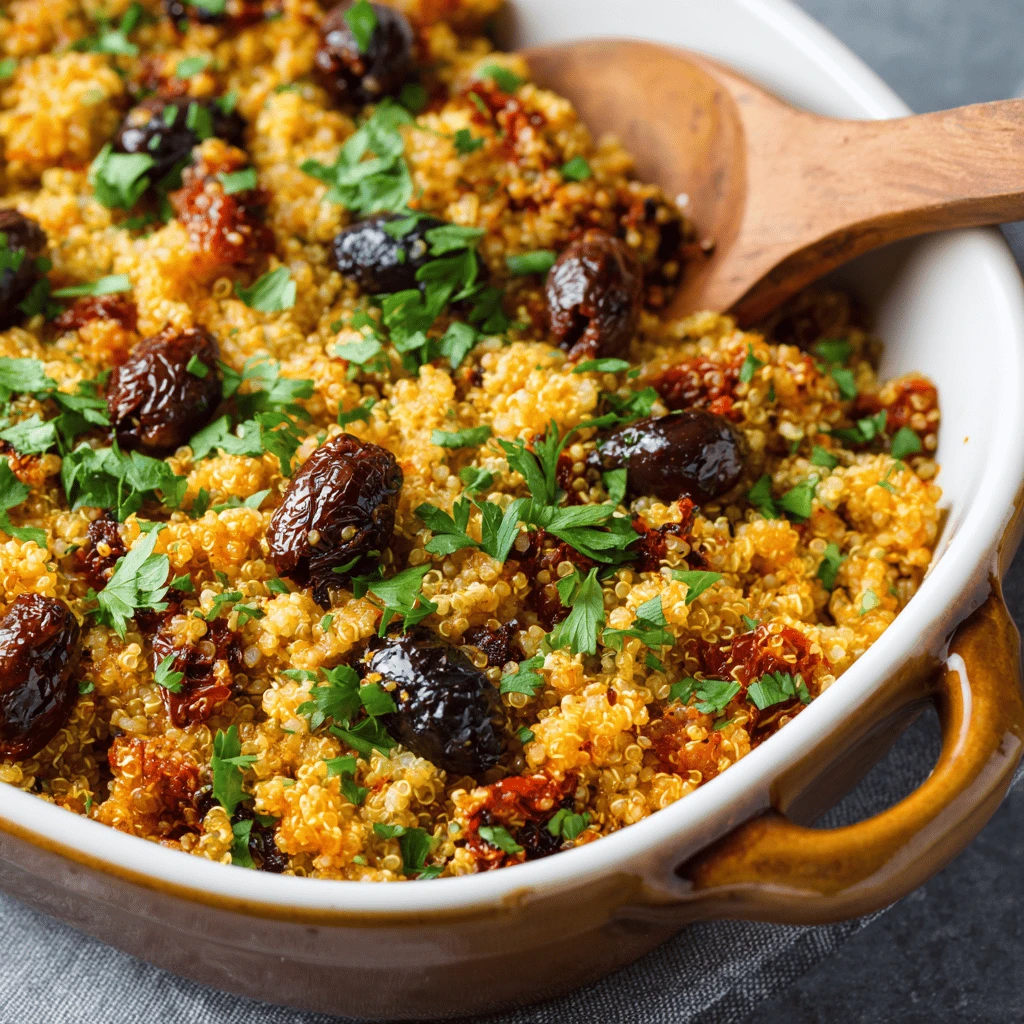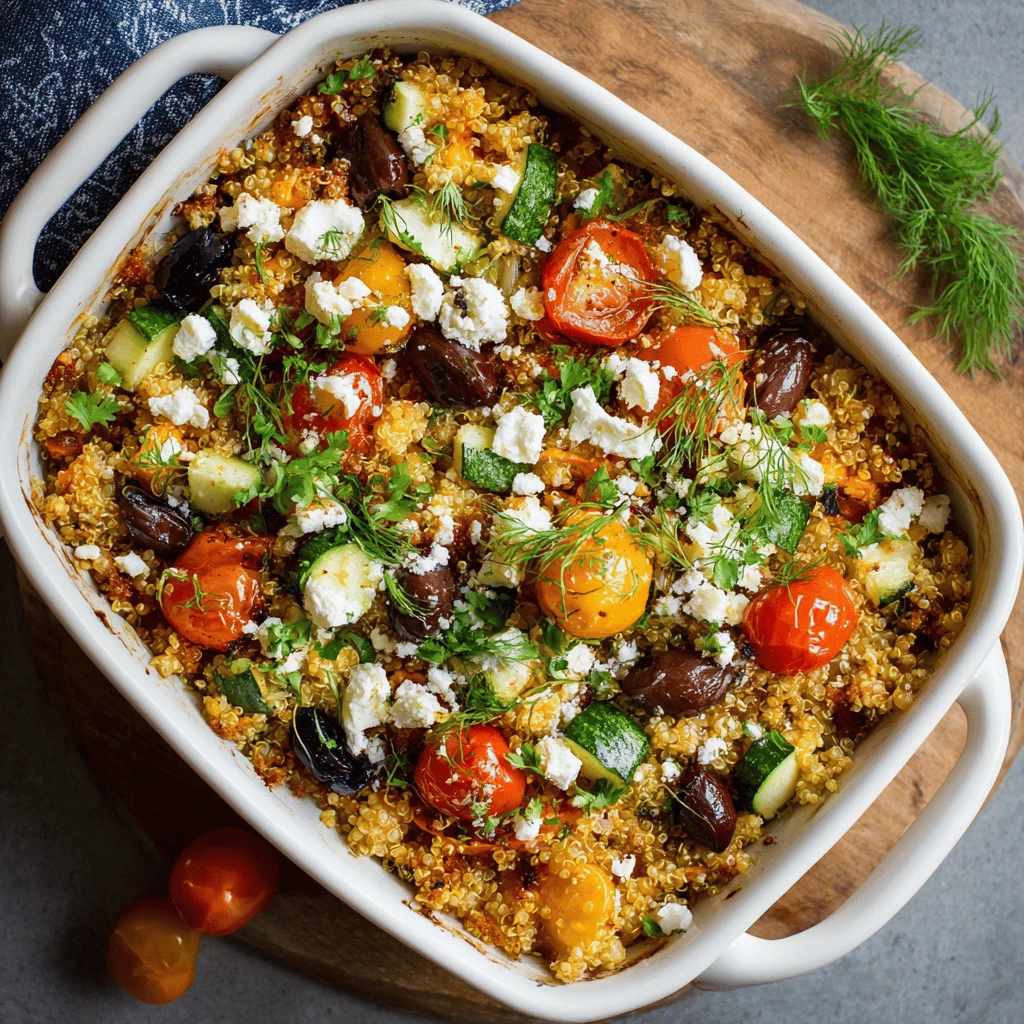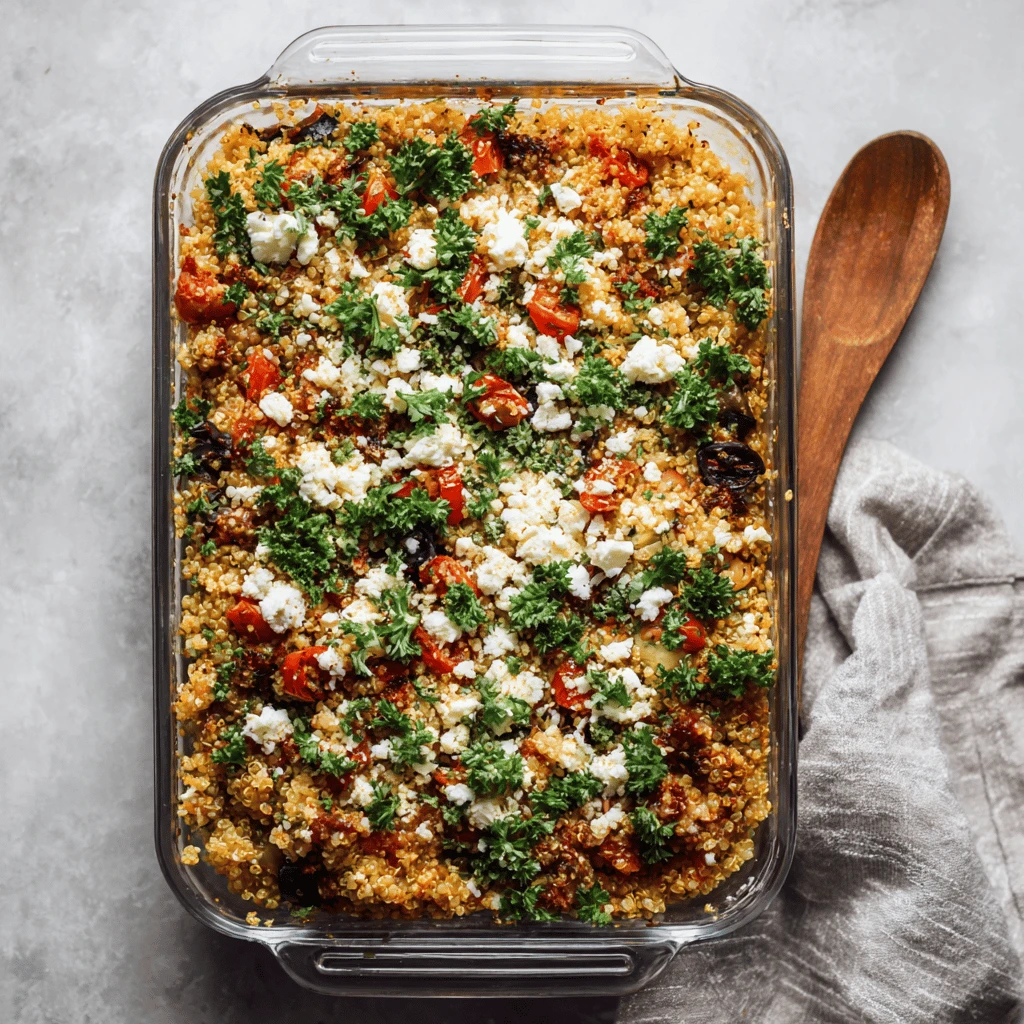Meal Prep Mediterranean Quinoa Casserole
Introduction to the Mediterranean Quinoa Casserole
Embark on a culinary adventure with the Mediterranean Quinoa Casserole, a dish brimming with vibrant flavors and wholesome ingredients. This recipe perfectly combines the health benefits of quinoa with the rich and diverse tastes of the Mediterranean diet. Ideal for meal prepping, this casserole offers a convenient and nutritious way to enjoy delicious, home-cooked meals throughout the week. It’s packed with protein, fiber, and essential nutrients, making it a powerhouse of goodness for your body.
This casserole isn’t just about healthy eating; it’s about savoring the joy of Mediterranean cuisine. Picture yourself transported to sun-drenched shores as you savor each bite, experiencing a delightful blend of textures and aromas. Whether you’re a seasoned chef or a novice in the kitchen, this recipe is incredibly easy to follow. It’s also highly customizable. Feel free to adjust the ingredients based on your preferences and what you have readily available.
The Mediterranean Quinoa Casserole is incredibly versatile, suitable for various occasions. It works well as a main course for a light lunch or dinner, or as a hearty side dish alongside grilled chicken, fish, or lamb. The leftovers are just as delicious, making it a time-saving option for busy individuals and families. Get ready to discover a new favorite that nourishes your body and delights your taste buds.
Key Ingredients and Nutritional Benefits
This casserole’s success hinges on a harmonious blend of ingredients, each contributing unique flavors and vital nutrients. Let’s explore the stars of this Mediterranean delight:
- Quinoa: This ancient grain is a complete protein, providing all nine essential amino acids. It’s also an excellent source of fiber, promoting digestive health and keeping you feeling full for longer. Quinoa is naturally gluten-free, making it a suitable option for individuals with gluten sensitivities.
- Mediterranean Vegetables: Embrace the vibrant colors and flavors of Mediterranean produce. Bell peppers (red, yellow, and orange) are rich in Vitamins A and C, boosting your immune system and promoting healthy skin. Zucchini offers a mild, slightly sweet flavor while providing essential minerals. Eggplant adds a smoky, earthy note and is a good source of antioxidants.
- Olives: A staple of the Mediterranean diet, olives contribute healthy fats, antioxidants, and a distinctive salty flavor. Choose from various types, such as Kalamata or green olives, to personalize your casserole’s taste profile.
- Feta Cheese: This tangy, salty cheese adds a creamy element and a boost of calcium. Opt for a lower-fat variety to reduce the overall calorie content without sacrificing flavor.
- Herbs and Spices: Fresh or dried herbs like oregano, basil, and thyme impart an aromatic depth to the casserole. Garlic and red pepper flakes add a touch of warmth and zest.
The nutritional benefits of this casserole are substantial. It’s a great source of complex carbohydrates, lean protein, healthy fats, and a wide range of vitamins and minerals. By incorporating this dish into your meal plan, you’re supporting overall health and well-being. It’s a flavorful and nutritious way to enjoy the benefits of the Mediterranean diet.
Step-by-Step Recipe Instructions
Creating this Mediterranean Quinoa Casserole is a straightforward process. Here’s a detailed guide to help you prepare this delectable dish:
Ingredients:
- 1 cup uncooked quinoa
- 2 cups vegetable broth
- 1 tablespoon olive oil
- 1 medium onion, chopped
- 2 cloves garlic, minced
- 1 red bell pepper, chopped
- 1 yellow bell pepper, chopped
- 1 zucchini, chopped
- 1 eggplant, chopped
- 1 cup Kalamata olives, pitted and halved
- 1/2 cup sun-dried tomatoes, oil-packed, drained and chopped
- 1/4 cup chopped fresh basil
- 1/4 cup chopped fresh oregano
- 1 teaspoon dried thyme
- 1/2 teaspoon red pepper flakes (optional)
- Salt and pepper to taste
- 4 ounces feta cheese, crumbled
Instructions:
1. Prepare the Quinoa: Rinse the quinoa thoroughly under cold water. In a medium saucepan, combine the quinoa and vegetable broth. Bring to a boil, then reduce heat to low, cover, and simmer for 15-20 minutes, or until the quinoa is cooked and the liquid is absorbed. Fluff with a fork and set aside.
2. Sauté the Vegetables: While the quinoa is cooking, heat the olive oil in a large skillet over medium heat. Add the onion and cook until softened, about 5 minutes. Add the garlic, bell peppers, zucchini, and eggplant. Cook until the vegetables are tender-crisp, about 8-10 minutes. Season with salt, pepper, and red pepper flakes (if using).
3. Combine Ingredients: Preheat your oven to 375°F (190°C). In a large bowl, combine the cooked quinoa, sautéed vegetables, olives, sun-dried tomatoes, basil, oregano, and thyme. Mix well to ensure all ingredients are evenly distributed.
4. Assemble the Casserole: Transfer the quinoa mixture to a greased 9×13 inch baking dish. Sprinkle the crumbled feta cheese evenly over the top.
5. Bake: Bake for 20-25 minutes, or until the cheese is melted and lightly browned, and the casserole is heated through.
6. Serve: Let the casserole cool slightly before serving. Garnish with fresh basil or oregano, if desired. Enjoy!
Tips for Success:
- Don’t overcook the quinoa. It should be fluffy and slightly chewy.
- Adjust the amount of red pepper flakes to your preference.
- Use fresh, high-quality ingredients for the best flavor.
- Feel free to add other vegetables like artichoke hearts or spinach.
Meal Prep and Storage Instructions
This Mediterranean Quinoa Casserole is an ideal candidate for meal prepping. Its robust flavors hold up well, and it reheats beautifully, making it a convenient option for busy weeknights. Here’s how to effectively prepare and store this dish for optimal freshness and taste:
Meal Prep Tips:
- Preparation Ahead: You can chop the vegetables and cook the quinoa up to 2-3 days in advance. Store them separately in airtight containers in the refrigerator. This will significantly reduce the cooking time when you’re ready to assemble the casserole.
- Assemble and Store: You can assemble the entire casserole, including topping it with feta cheese, and store it covered in the refrigerator for up to 24 hours before baking. This allows the flavors to meld together even more.
- Portioning: Divide the cooked casserole into individual serving containers for easy grab-and-go lunches or dinners. This also helps with portion control.
Storage Instructions:
- Refrigeration: Store leftover casserole in an airtight container in the refrigerator for up to 3-4 days.
- Freezing: For longer storage, freeze individual portions of the casserole in freezer-safe containers or bags. Ensure the casserole is completely cooled before freezing to prevent ice crystals from forming. It can be frozen for up to 2-3 months.
- Reheating: To reheat, thaw the frozen casserole in the refrigerator overnight. Reheat in the oven at 350°F (175°C) until heated through, or microwave individual portions until warm. You may want to add a splash of water or broth to prevent it from drying out.
By following these meal prep and storage tips, you can enjoy the delicious and nutritious Mediterranean Quinoa Casserole throughout the week without sacrificing flavor or quality. It’s a fantastic way to streamline your meal planning and ensure you always have a healthy option readily available.
Variations and Customizations
One of the best aspects of this Mediterranean Quinoa Casserole is its adaptability. Feel free to experiment with different ingredients and flavor combinations to create a dish that perfectly suits your taste preferences and dietary needs. Here are a few ideas to inspire your culinary creativity:
- Protein Boost: Add grilled chicken, chickpeas, or white beans for an extra boost of protein.
- Cheese Variations: Instead of feta, try using goat cheese, mozzarella, or Parmesan cheese.
- Spice It Up: Increase the amount of red pepper flakes or add a pinch of cayenne pepper for a spicier flavor.
- Vegetable Substitutions: Swap out some of the vegetables for others you enjoy, such as spinach, artichoke hearts, sun-dried tomatoes (oil-packed), or mushrooms.
- Herb Combinations: Experiment with different herbs like rosemary, dill, or mint.
- Lemon Zest: Add a tablespoon of lemon zest to the quinoa mixture for a bright, citrusy flavor.
- Vegan Option: Omit the feta cheese or substitute it with a vegan cheese alternative. Ensure that vegetable broth is vegan.
- Grain Alternatives: While quinoa is recommended, you can also use brown rice, farro, or couscous as a base for the casserole.
These variations allow you to tailor the Mediterranean Quinoa Casserole to your liking. Whether you’re looking to add more protein, adjust the spice level, or incorporate your favorite vegetables, the possibilities are endless. Don’t be afraid to get creative and make this recipe your own. Each variation offers a unique flavor profile, ensuring that you never tire of this versatile and nutritious dish.
Frequently Asked Questions (FAQ)
-
- Can I make this casserole ahead of time?
Yes, you can assemble the casserole up to 24 hours in advance and store it in the refrigerator before baking. This allows the flavors to meld together.
-
- How long does the casserole last in the fridge?
The cooked casserole can be stored in an airtight container in the refrigerator for up to 3-4 days.
-
- Can I freeze the quinoa casserole?
Yes, you can freeze individual portions of the casserole in freezer-safe containers or bags for up to 2-3 months.
-
- What can I serve with this casserole?
This casserole is delicious on its own or served with a side salad, grilled chicken, fish, or lamb.
-
- Is this casserole gluten-free?
Yes, this casserole is naturally gluten-free, as it uses quinoa as the grain base.
-
- Can I make this casserole vegan?
Yes, omit the feta cheese or substitute it with a vegan cheese alternative. Ensure that vegetable broth is vegan.
-
- What kind of olives should I use?
Kalamata olives are a popular choice, but you can use any type of olives you prefer, such as green olives or black olives.
-
- Can I use dried herbs instead of fresh?
Yes, you can use dried herbs if you don't have fresh ones available. Use about 1 teaspoon of dried herbs for every tablespoon of fresh herbs.
-
- Do I need to rinse the quinoa before cooking?
Yes, it's recommended to rinse the quinoa before cooking to remove any bitterness.




